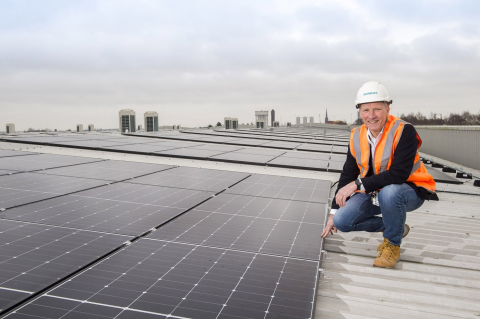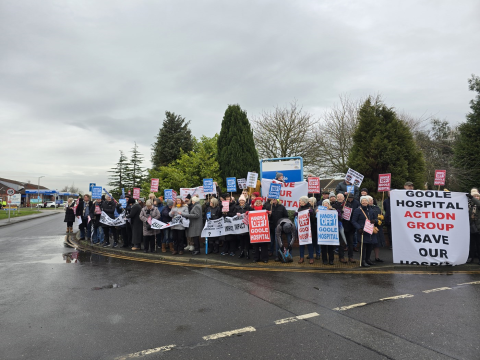

A total of 1,700 solar panels have been switched on by Siemens Mobility at its Goole Rail Village, as part of a range of low carbon investments to reduce the site’s carbon footprint.
The Rail Village now has minimal operational emissions, with green energy generation, clean heating systems and sustainable transport policies in its bid to become net zero in its operations by 2030. Siemens Mobility has set ambitious targets to reduce emissions in its own operations by 55 per cent by 2025, and 90 per cent by 2030, with the production of its own renewable energy at sites such as Goole playing a vital part in that transition. It has installed 1,700 solar panels across the three manufacturing buildings at the Goole site, which have now been connected and are capable of generating up to 1MW of clean energy – the equivalent of powering more than 150 homes. Sited on the trucking, final assembly and commissioning buildings, the £2 million solar array covers almost 20,000 square metres of roof space and is producing sufficient energy to meet the site’s needs. Green energy produced by the panels during the site’s non-production hours, such as during weekends, is exported back to the grid, while any additional energy required during peak times is exclusively from renewable sources. The solar array complements other sustainability measures which are contributing to the Goole site’s low carbon credentials.
Siemens Mobility has invested £2 million to install more than 40 localised air source heat pumps to heat the production facilities at Goole, an initiative projected to cut its carbon output by 980 tonnes per year, an 88 per cent reduction. The business is also electrifying its vehicle fleet and rolling out electric vehicle charging points across the Goole site to ultimately install around 70 chargers, one for every 10 parking spaces. All employees are encouraged to adopt greener methods of transport, such as cycling, using public transport or car sharing. Siemens Mobility has also been a key driver in establishing the successful Goole + Howden Hopper bus service, improving connectivity between Goole, Howden and key employment sites on the outskirts of the town.
Finbarr Dowling, Siemens Mobility Director of Localisation, said: “Our vision from the very outset was for the Goole Rail Village to be net zero in its operations by 2030, with this state-of-the-art facility playing a central part in our mission to transform rail travel and transport in the UK. “This strategic focus has informed the development of a state-of-the-art rail cluster that leads the way on decarbonisation for the industry, with facilities that are streets ahead of many across the sector. “It also underpins everything we do at Goole, ensuring that our buildings, energy generation and consumption, how we work, and travel to and from the site all minimise our carbon impact. “That is hugely important for us, as a business committed to the highest sustainability standards, as well as to our customers, stakeholders and partners as they strive for excellence in environmental responsibility. We’ve made great progress in this journey to net zero, however there is more to do and we will continue to seek to remove carbon from our own operations between now and 2030.”
Siemens Mobility’s investment of up to £240 million in the Goole Rail Village represents a significant commitment to the North of England, with the site featuring manufacturing, components, logistics, innovation and office facilities, establishing the site as a centre of excellence for rail technology in the UK. The highly anticipated new Piccadilly line trains for Transport for London (TfL) that will transform rail travel across the capital are being assembled at the Goole site, before they start to enter service by the end of this year. Siemens Mobility also plans to build all future main line trains for the UK at Goole, including new battery bi-mode trains that it has calculated could save Britain’s railways £3.5 billion and 12 million tonnes of CO2 over 35 years. The latest phase of the Rail Village will see the addition of a Bogie Assembly and Service Centre, representing an additional investment of up to £40 million which means Siemens Mobility’s overall investment in the East Yorkshire town is up to £240 million, bringing up to 1,000 new jobs to the site as well as around 1,700 supply chain opportunities. David Harris, Siemens Mobility construction project manager, said: “Our carbon reduction strategy for the Goole Rail Village has been implemented over a number of years. “We’ve considered how best to minimise our carbon footprint at every stage, including throughout the development and construction phases. With the rail manufacturing facility now operational, we’re seeing the full benefits of building sustainability into the project from day one.”
Construction Project Manager David Harris with part of the array of 1,700 solar panels on the manufacturing buildings at Siemens Mobility’s Goole Rail Village, which are capable of generating up to 1MW of clean energy. Courtesy Hull News & Pictures. (27-02-106 SU)



